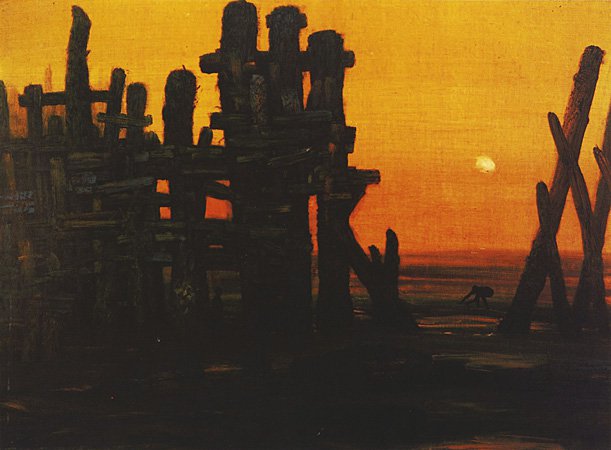Cultural Center of the Philippines
ENCYCLOPEDIA OF
PHILIPPINE ART
Pantalan
(Wharf) / 1963 / Acrylic on canvas / 60 x 80.5 cm / Artist: Juvenal Sanso / Private collection
Sunset by the rivers, rocks by the seashore, lurking shadows on a deserted beach, and cryptic vegetation are images that fascinate Sanso. From memory he would recreate these into surreal compositions, such as in the seascape Pantalan. Here he painted biomorphous forms laid out like a crisscross pile of lonely derelicts. An illusionary texture of crisp, mossy stumps of wood decaying in aqueous soil is rendered in thin, controlled applications of pigment in finest calligraphic methods of washing, bubbling, splashing, and brushing. The marshy blues, blacks, and browns, built up into scaffoldings on an elegiac quagmire, dramatically contrast the brilliant, flat yellow of the tropical sky.
When talking of feeling as reflected in his painting, Sanso says: “I paint suffering, loneliness, and anguish, because I know these intimately.” But Sanso’s angst is never literal nor emotional. Rather, loneliness is expressed in restrained reveries of a looming atmosphere, and in this particular work, it is silhouetted with the diminutive shadows of two stalkers.
About his creative process, Sanso reveals: “First I think of things in space, in light, and the objects spring out of the picture slowly.” Thus like the abstract expressionism of his Parisian milieu during his artistic formation in the mid-1950s, Sanso painted from the unconscious; but unlike abstract expressionism, the physical presence that he painted transcended to the sublime. Thus whether the seascape is of Brittany, Parañaque, Cavite, Montalban, or a pantalan, it actually is a mindscape created by a romantic artist in catharsis.
Written by Imelda Cajipe-Endaya
